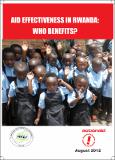| dc.description.abstract | Rwanda, one of the poorest and most aid dependent countries in the world, has made dramatic development
progress since 2006 and is now on track to achieve most MDG targets by 2015. Its development strategy
has fuelled economic growth and transformation, reduced dependency on aid and insured that the poor have
benefitted from economic growth.
It remains, however, the fifth most aid dependent country in the world and is likely to remain aid dependent in
the medium term. Poverty levels and economic inequalities remain high, and reducing poverty and providing
decent employment remain challenges. Despite strong economic growth the tax base remains shallow and
narrow, with only 11 percent of enterprises registered with the Rwanda Revenue Authority and only 25 per
cent of workers in non-farm work. Domestic savings rates are low with only a fifth of adults having a savings
account with most saving to manage short term fluctuations in spending and/or risk avoidance. Attracting
foreign direct investment is proving challenging and with investment well below the levels being attracted
to Uganda and Tanzania. Despite growing exports there has been a worsening balance of trade with the trade
deficit widening by 40 percent between 2010 and 2011. Non-farm employment growth, with a growth rate
of six percentage points between 2005/6 and 2010/11, needs to be accelerated to meet the numbers of new
labour market entrants expected over the next 10 years. There is a need to continue to mainstream gender
and introduce gender based budgeting and to fight HIV/AIDS where the infection rate of three per cent has
remained stagnated in recent years.
The development progress under EDPRS-1 has undoubtedly been driven by a strong and determined Government
supported by committed DPs. One clear indicator of this is the increase in ODA to help meet the cost of
implementing the strategy. Strong country ownership and leadership of the development agenda, combined
with community participation and supportive DPs has brought about genuine and sustainable progress, even in
one of the poorest countries and without full commitment to the aid effectiveness agenda by DPs.
As Rwanda reviews its progress under EDPRS-1, it is appropriate to review the effectiveness of development
aid, the role it has played in prompting sustainable economic growth and transformation as well as reducing
poverty and inequality. A key question is the extent to which development aid is being invested to do itself out
of a job. We can also ask if aid is being delivered in the most effective and efficient way. Is it providing good
value for money and is it being invested to support the Government’s development agenda? Are there ways
in which it could be delivered more effectively and efficiently and potentially support even more development
progress under EDPRS-2? Are development partners implementing their commitments to the Paris Declaration?
Aid flows have continued to increase, although aid dependency (proportion of Government budget from
development aid) has declined from 86 per cent in 2000 to 43 per cent in 2011/12. The Government has
taken strong ownership of development support, skilfully taking up DAC DP’s rhetoric to exert leverage and
bring its negotiating capital into play. The 2006 Aid Policy clearly incorporates and goes beyond the Paris
Agenda. Rwanda was one of only two countries to be awarded an A grade in the OECD 2010 evaluation of the
implementation of the Paris Agenda.The use of EDPRS as the framework for the allocation of resources,including
development aid, has not only provided a useful guiding principle,but has also undoubtedly made a significant
contribution to the achievement of results. It has ensured that aid is allocated to productive as well as social
sectors, thus fuelling sustainable development and building human capacity as well as enabling the poorest
and most vulnerable to exit poverty. There is evidence that DPs give assistance in line with EDPRS priorities
even if the assistance is not always provided in the way the Government would prefer. Thus much development
aid in Rwanda is ‘real aid’, aid that is it helping to fuel a virtuous spiral of development that is benefitting all
Rwandans. | en |


